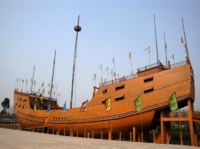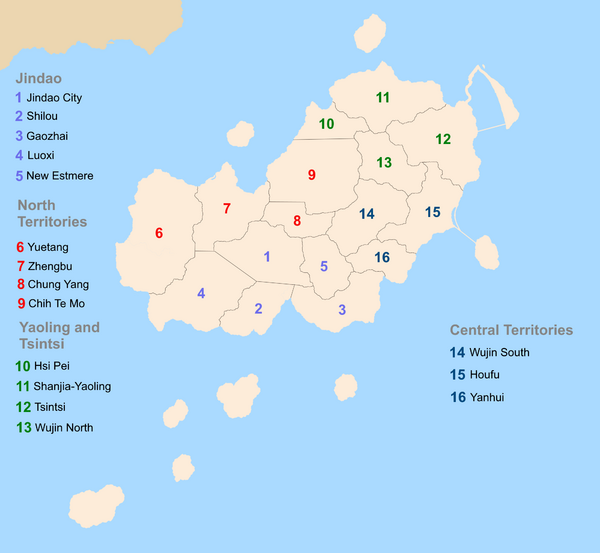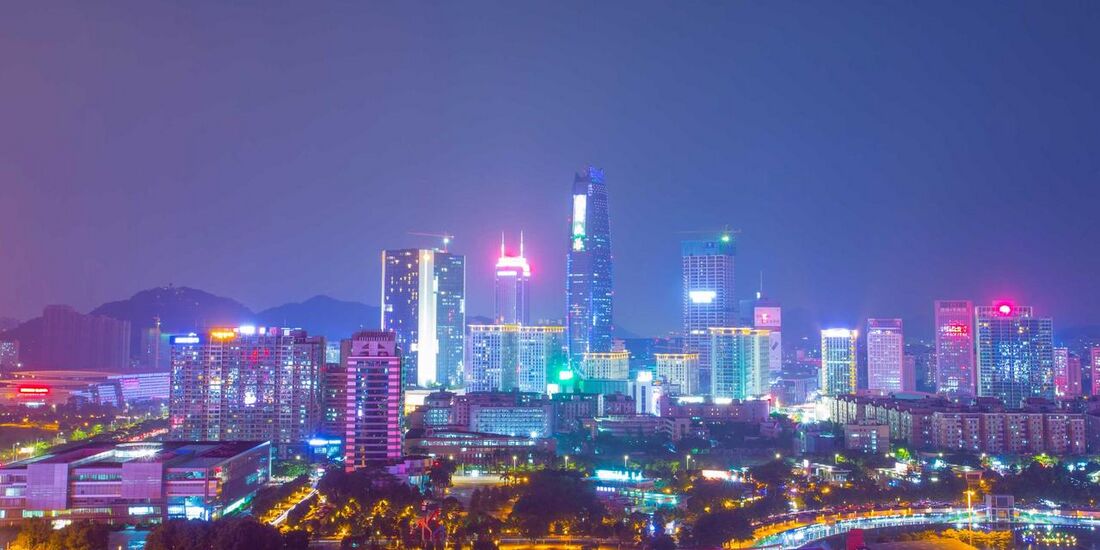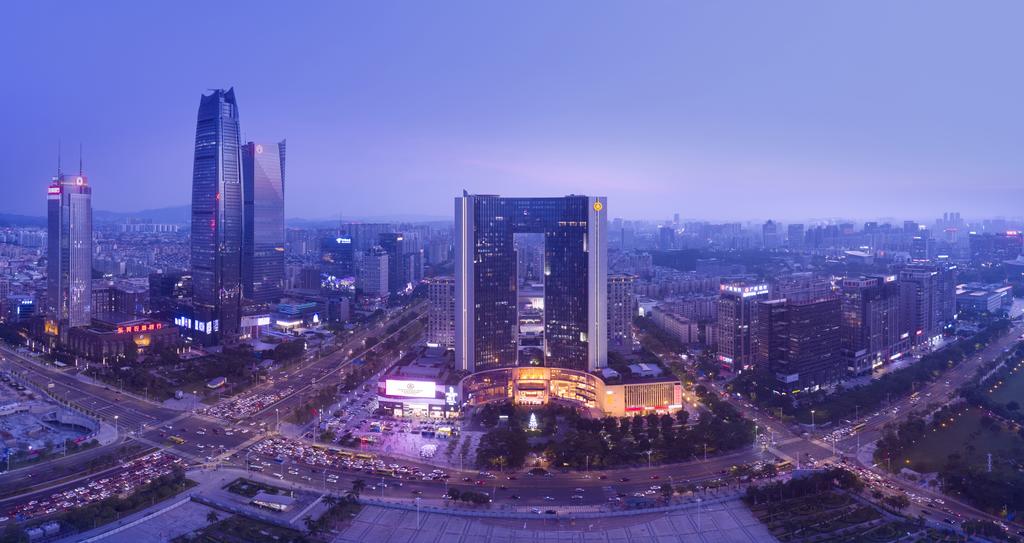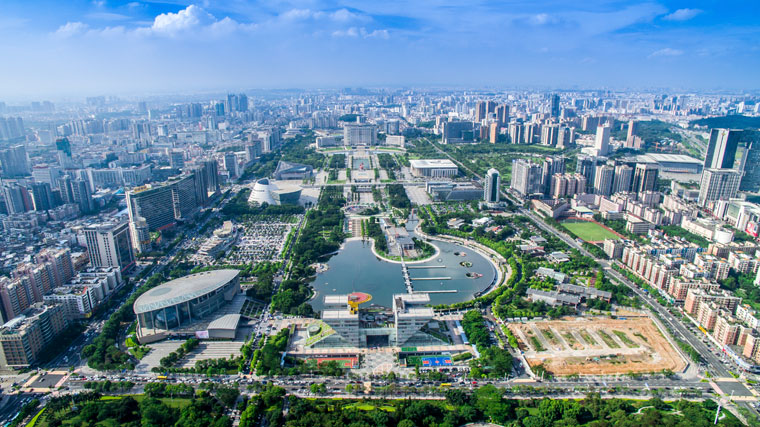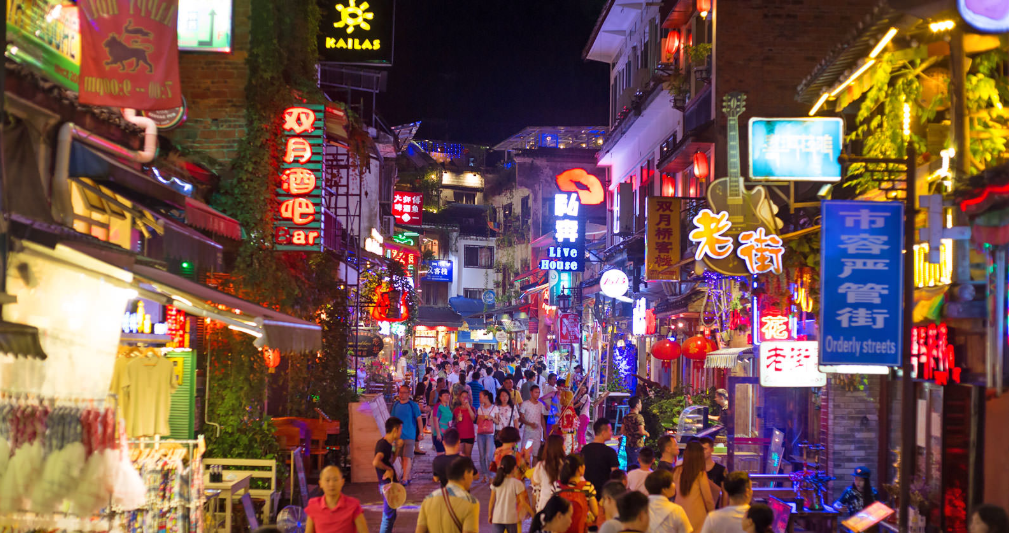Jindao: Difference between revisions
| Line 275: | Line 275: | ||
* {{flagicon|Estmere}} [[Ashcombe]], [[Estmere]] | * {{flagicon|Estmere}} [[Ashcombe]], [[Estmere]] | ||
* {{flagicon|Swetania}} [[Ostapils-Baihaven]], [[Swetania]] | * {{flagicon|Swetania}} [[Ostapils-Baihaven]], [[Swetania]] | ||
* {{flagicon|Werania}} Ostdorf am Main, [[Werania]] | |||
Revision as of 14:33, 16 September 2019
This article is incomplete because it is pending further input from participants, or it is a work-in-progress by one author. Please comment on this article's talk page to share your input, comments and questions. Note: To contribute to this article, you may need to seek help from the author(s) of this page. |
Template:KylarisRecognitionArticle
Jindao Autonomous Administrative Territory of the Auspicious Republic of Xiaodong 晓东吉祥共和国金岛自治区 Xiǎodōng jíxiáng gònghéguó Jīndǎo zìzhìqū (Xiaodongese) Territoire administratif autonome de Jindao de la République de bon augure de Xiaodong (Gaullican) | |
|---|---|
| Motto: "要为金岛而荣耀" "To glory for Jindao!" | |
| Anthem: "英勇的戰士" ("Heroic Warriors") | |
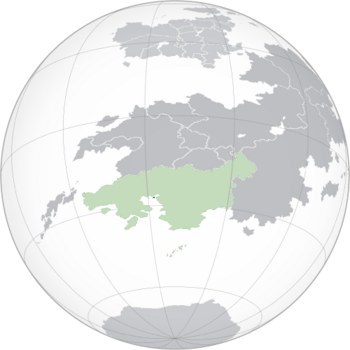 Location of Jindao (green) within Xiaodong (light green) | |
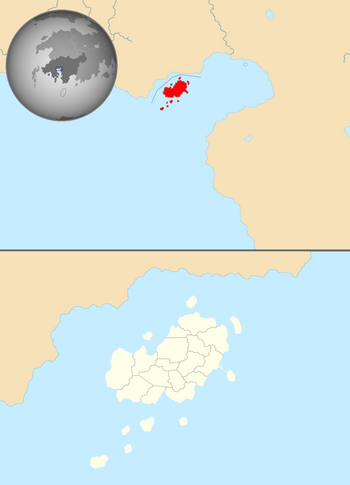 Map showing Jindao's location in Coius, on Xiaodong's south coast, and Jindao's 16 provinces | |
| Official languages | Jindanese Xiaodongese Gaullican Estmerish |
| Ethnic groups (2019) | 70.8% Jindanese 14.2% Xiaodongese 9.6% Mathra 2.1% Estmerish 1.7% Gaullican 0.5% Other |
| Religion (2019) | 44.1% Solarian Catholic 38.2% Taojiao 15.6% Irreligious 2.1% Other |
| Demonym(s) | Jindanese |
| Government | Devolved executive-led government within a unitary authoritarian republic |
• Chief Executive | Guo Zhenya |
• Chief Secretary | Liao Cai |
| Legislature | Biao |
| Autonomous Region of Xiaodong | |
• Xiaodongese subjugation | 1202 |
• Gaullican colony | October 17, 1884 |
• Estmerish colony | February 20, 1935 |
• Xiao-Estmerish Jindao Treaty | May 2, 1990 |
• Transfer of sovereignty from Estmere | April 10, 1996 |
| Area | |
• Total | 1,125.6 km2 (434.6 sq mi) |
• Water (%) | 61.4 |
| Population | |
• 2019 census | 6,541,201 |
• Density | 15,055/km2 (38,992.3/sq mi) |
| GDP (PPP) | estimate |
• Total | $541.7 billion |
• Per capita | $82,819 |
| GDP (nominal) | estimate |
• Total | $506 billion |
• Per capita | $77,361 |
| Gini | high |
| HDI | very high |
| Currency | Jindanese Nacar (NAC) Xiaodongese Renjin (RJN) |
| Date format | yyyy-mm-dd |
| Driving side | right |
| Calling code | +891 |
| Internet TLD | .jn |
Jindao, officially the Jindao Autonomous Administrative Territory of the Auspicious Republic of Xiaodong is a special administrative region in the centre of the X in central Xiaodong. With 6,541,201 people and an area of 1,125.6 km², around 60% of which is water, it is one of the most densely populated regions in the world. The city of Shilou, within the Jindao metropolitan area, is the most densely populated city in the world, with a population of 2,541,205 and an area of 63.83km² (including the Tanpe, Tangqiu, Mathratown and Weikan districts), the city has a population density of 39,812 people per square kilometre.
The city-state of Jindao was an independent kingdom for much of its history, with little instability ever rocking the nation and the port of Jindao being a hub for trade in the southern Coius region. Coming under Xiaodongese subjugation at the start of the 13th century, the city continued to flourish under Xiaodongese control as more resources and revenue from mainland Xiaodong were directed in the way of the island due to the decreased trade regulations between the two states. Also formerly a colony of Gaullica after it was relinquished by Xiaodong as a treaty port in 1884, Jindao acted as a naval base for Gaullica (and Xiaodong) throughout the Great War. After Gaullica's loss in the war, the city's sovereignty was transferred to Estmere, under whom more rights were guaranteed and more democratic reforms were instated, including the reformation of the Biao as a devolved government under Estmere in 1949. The country flourished as women's suffrage was introduced in 1953, and the legal recognition of homosexual marriage being introduced in 1966. In 1990, Estmere and Xiaodong signed the Xiao-Estmerish Jindao Treaty, an agreement which promised the sovereignity of Jindao to be returned to Xiaodong in exchange for the customs of rights of the city to remain unchanged and guaranteed. Estmere officially relinquished sovereignity of the island in 1996, returning it to Xiaodong after 112 years of Euclean rule. Jindao acts as an Autonomous Administrative Territory (AAT) of Xiaodong, whose legislature and government is separate from that of the mainland.
A bustling city off the coast of Xiaodong, Jindao is a major resort city with the highest tourists-per-capita of any city in Coius. The Jade Square in central Jindao is renowned for its wide assortment of cultures, cuisines and activities, with entertainment such as theatres, casinos and restaurants adorning much of the square. It is one of the highest recipients of tourism revenue and tourism accounts for most of country's economy.
Jindao has high rates of urbanisation centred around the main Jindao island, with one of the highest Human Development Indexes in Kylaris, standing at 0.914. The Jindanese government is working on increasing residential capacity on the outlying islands as well as reclaiming land from the sea to use as residential suburbs and estates.
Etymology
The first instance of the island being called "Jindao" is from the early 2nd century, when Xiao settlers began to inhabit the island and naming it after its fabled beaches, likely where the Jindao Harbour is today, albeit the name was used to refer to the island itself rather than the name of the country owning it. Jindao has also been known under several different similar names, with "Jindau" sometimes being used to refer to the island and "Chintow" being the official name of the island whilst it was under Gaullican rule and also partially under Estmerish rule until the postal romanisation stopped being used in X, where it was renamed to its traditional name.
History
Jindao was first settled in the 2nd century AD, when Xiaodongese settlers migrated in from what is now the city of Lunkeng, around 12 kilometres north of the island. The Xiaodongese settlers brought their customs and traditions of classical antiquity Xiaodong to the island and it effectively functioned as an offshoot of Xiaodong despite the island being an independent entity. The knowledge of rice cultivation was brought from the mainland and the island flourished as an ideal place for rice growth and farming. Due to its unique climate, Jindao was initially a slow-developing city, with most of the island being used exclusively for rice farming. In 281 AD, Yao Jin consolidated the city of Jindao and proclaimed the Yao Dynasty as a separate kingdom to the mainland and claimed the entire island for the empire. His armies quickly seized the island (at this point mainly unsettled forest) to prevent the intervention of the Xiang dynasty of Xiaodong.

The Yao dynasty of Jindao did not last long, and Yao Jin would be its first and last independent emperor. News of the formation and breakaway of the Yao dynasty from the now-centralised Xiang dynasty angered the Emperor, who ordered that Jindao be vassalised and later fully integrated into the Xiang realm. In 286 AD, the Xiang Emperor launched a full invasion of Jindao utilising much of the standing Xiao forces. With the combined forces of the Xiang navy and army ready to launch a full naval invasion of Jindao, Emperor Yao Jin presented a peace offering to the Xiang Emperor, in which Jindao would surrender the island provided it is given some autonomy and the Yao dynasty retaining the right to rule the island as a subordinate leader under the Xiang. Fearing a possibly costly battle for the small and largely uninhabited island, the Xiang Emperor conceded and allowed Jindao to keep its autonomy provided it surrendered the island. The Xiang forces were allowed through the Jindao Harbour and docked in Jindao, where Xiang general Ma Xue, commander of the forces invading Jindao, was invited into the Yuhan Palace to sign the agreement. Xue and Emperor Yao Jin are told to have walked out of the palace together, treaty in hand, and announcing to the gathered crowd of Jindanese farmers, civilians and Xiao soldiers of the peace between the nations. The treaty was known as the Yuhan Palace Treaty and was the first step in Jindao's long endowment of autonomous status.
Jindao would continue to co-exist with the Xiang dynasty throughout the rest of the mid-Xiang period and into its downfall, and participated little in the fighting that ensued following the Xiang dynasty's demise. Jindao became a refugee haven for the upper-class Xiaodongese fleeing from infighting during the period of the Four Kingdoms, with old members of Xiang royalty as well as Xiang loyalists who owned land in mainland Xiaodong fleeing to the island in search of safety and refuge. The vast amounts of wealth that came into the island allowed Jindao to be built up quickly and by around 520 AD the island was technologically on par with the mainland for the first time in its history. Many modern day districts were first referenced during the time of the city's restructuring, including Tulihe and Laoshizhai in Emperor Yao Tai's census of the island in 534 AD, which recorded a population of 79,000.
The Yao dynasty officially came to an end in 1202 when the Tao dynasty commanded its full annexation into the Tao realm, with the Yao Emperor not putting up much resistance and being allowed to live in Jindao as a figurehead following the annexation. Jindao served as an important naval port during the wars with Senria that were waged throughout the Tao era. Opinion of the Tao dynasty in Jindao was poor due to the repression of Jindanese customs in favour of more Xiaodongese-oriented ones, and following the wars with Senria as well as the economic decline of the dynasty, Jindao supported the Jiao family in their coup of the throne in 1415. Among the reign of the first Jiao emperor, the wealth accumulated by trade coming into Jindao was often lavishly spent on things for the emperor himself, and the Jiao family quickly squandered the wealth that had existed in Jindao for centuries. Despite this, the creation of Taojiao and its teachings was welcomed by Jindao and it quickly became the dominant religion of the island. Jindao again served as an important naval port for the invasion of Senria, but the island was affected by the peasant uprising that ultimately led to Xiaodongese defeat in the war. Zhengbu was a peasant stronghold during the uprising. Christianity - mainly Solarian Catholicism - arrived in the 17th century and was repressed within Xiaodong and Jindao, but some underground sects of newly-converted worshippers developed, most notoriously the Tàiyáng lóng (太阳龙; "Solar Dragons"), who burnt down the north side of the Yuhan Palace in 1656 and attempted to assassinate the emperor of Xiaodong in 1657, while he was on a visit to Jindao. By the time the Solar Dragons rose to prominence, the Jiao dynasty had long been in decline, largely due to the growing influence of Solarian Catholicism and the economic consequences of their luxury spending. In 1667, following another coup, a Senrian mercenary known as X seized Xiaodong and began the Toki-era of the country.
The Toki dynasty began change almost immediately, implementing a new government system akin to that of Senria's, changing some of the customs that had existed in Xiaodong for millennia. Jindao was also affected by this change, with the new Senrian government system increasing centralisation and making Jindao subjected to increased direct rule from Rongzhuo. The swift change of the ethnicity of the higher class of Xiaodongese society angered most Xiaodongese people, who hated seeing the people they had fought so long to undermine ruling over their lands. The existence of the Toki dynasty was the initial step in the development in Xiaodongese nationalism and the loss of wars to many Euclean powers and the unequal treaties that followed only amplified and spread the newfound ideology. Ruler of the Toki dynasty oversaw many technological developments and the increase in free markets and capitalistic policies did wonders for the Jindanese economy, skyrocketing free trade and economic growth in the port city which allowed it to quickly industrialise at a much faster rate than its mainland counterparts. Due to this, migration to Jindao increased, especially from of the city of Lunkeng, just across the strait. By 1868, the date of the Toki dynasty's overthrowing, Jindao had a population of over 200,000. The beginning of the Heavenly Xiaodongese Empire and the reign of the Xiyong Emperor oversaw the renegotiation of the unequal treaties that had defined the previous dynasty. One of these renegotiations, ratified in 1884, oversaw the transferral of sovereignty of Jindao to Gaullica as part of a new agreement of an alliance between the two nations. The sovereignity of Jindao officially switched hands on October 17, 1884.

Gaullica immediately sought out reform within Jindanese society, introducing Solarian Catholic beliefs and repressing the native Jindanese language in favour of Gaullican. In 1887, development of a rail network, both overground and underground, began in Jindao, and just two years later the first underground line was opened, travelling between East Yanglin and West Tulihe, beginning the now-expansive Jindanese metro system. The introduction of Euclean technology and innovations bolstered Jindao's economy and it became a largely Euclean-influenced island in Coius. New sewage systems spanning the streets of Jindao were created in the late-1890s to early-1900s, drastically reducing disease spread on the island. Jindao once again served as an important army and naval outpost in Coius for Gaullica, giving the empire a base in southern Coius from which to project its influence from. Xiaodongese and Gaullican troops and equipment were stationed in Jindao throughout the Great War and the island saw some of the first wars it had ever seen on its home shores during the conflict. Following Senrian landings across Xiaodong, the Battle of Jindao began in August 1933, with the subsequent Senrian Occupation of Jindao being completed by March the following year. After the Entente surrendered in 1935, the island was transferred to Estmere as part of the peace treaty. Jindao entered the Community of Nations with Estmere in 1935.

Democratic reforms in Estmere also applied to Jindao, and in 1949, the Biao, originally the court of the Yao emperors, was recreated as a devolved legislative parliament to supply Jindao with autonomy within the declining Estmerish colonial empire. The reforms were met with widespread praise and the satisfaction with Estmerish rule was high. Societal reforms continued to be implemented, with women's suffrage introduced in 1953 and the legalisation of homosexuality ratified in 1966. The post-war depression experienced by much of Euclea and Coius also encouraged widespread migration to Jindao, especially among the upper class and conglomerates in their countries. Taxes in Jindao were reformed in 1971 to attract large multinational corporations to base their operations in Jindao, allowing companies to avoid taxes through the lack of filed public accounts in Jindao and all countries with bilateral tax treaties with Jindao. Jindao also operates a policy of financial secrecy. Following the swift decline of Estmerish colonialism in the 20th century, the question on whether Estmere could continue to rule Jindao with the growing industrial power of Xiaodong pressuring the country to begin negotiations on the port's return. In 1990, the two nations signed the Xiao-Estmerish Jindao Treaty, agreeing that as long as Xiaodong preserves the autonomy and liberties of Jindao, the port will be returned back within ten years. After the end of the Duljunese War in 1996, Jindao was returned back to Xiaodong as an Autonomous Administrative Territory, similar to that of Duljun, signalling the end of Estmerish colonial rule. Jindao's economy has continued to skyrocket through its taxing policy and the one city boasts a GDP more comparable to some countries, standing at just over $500 billion. Population growth in Jindao in increasing and the city is beginning to face a residential housing crisis with the amount of migration globally, although this has begun to be combatted with the construction of the Yuetang Residential District, Yaoling City and Houfu. The 2019 Mathratown protests are ongoing amidst calls for more Jindanese liberty and independence.
Government and politics
Jindao is an Autonomous Administrative Territory (AAT) of Xiaodong, with executive, legislative and judicial powers devolved from the national government. The Xiao-Estmerish Jindao Treaty laid out the framework for the continuation of Jindanese economic and administrative sovereignty following the transferral of the port back to Xiaodong in 1996. Largely influenced from the port's history as an Estmerish colony, Jindao operates an executive-led system. The law of Jindao acts as a basic uncodified constitution for the region, although Xiaodong reserve the right to impose the law of the Xiaodongese constitution on the city, although it is unlikely they will do so.


The regional government, known as the Biao, is composed of three branches:
- Executive: The Chief Executive is responsible for enforcing regional legislature, forcing the reconsideration of legislature, and represents Jindao in official meetings as its de facto head-of-state.
- Legislature: The Legislative Council are responsible for the drafting of legislature and presenting it before the Executive Council (which is elected every five years in a non-partisan democracy). The Legislative Council also approves the fiscal budget for the territory and as the power to impeach a sitting Chief Executive with a three-quarters-majority vote.
- Judiciary: The Judiciary of Jindao have the responsibility of interpreting regional law and reject bills inconsistent with existing law. Members of the Judiciary are appointed by the Executive Council.
The Chief Executive, currently Guo Zhenya, serves as the region's de facto head-of-state and its head-of-government, and can serve for one five-year term. The Premier of Xiaodong appoints the Chief Executive with guidance from the elected Executive Council, composing of 20 members.
The Legislative Council consists of 180 members, all of which serve a 5 year term. The 180 members are split between the 90 constituencies of Jindao and 90 functional constituencies that represent corporations and organisations, high-ranking people and special interest groups. Political parties can run for the Legislative Council, but not for the Executive Council, as a result many send their party leader or other high ranking officials to campaign for executive election, while the main bulk of the party campaigns for the Legislative Council. A total of 12 political parties won seats in the 2016 Legislative elections.

Xiaodongese national law does not usually apply within the region, and is one of the core principles in Jindanese autonomy, the region operates its own seperate laws enforced by the Judiciary. Jindao operates a separate immigration policy to the mainland, and citizens of Xiaodong do not have right of abode in Jindao. Citizens of Xiaodong must pass immigration laws like anyone else.
The Xiaodongese military is responsible for the region's defense, as outlined in the Xiao-Estmerish Jindao Treaty.
Administrative divisions
Jindao is divided into sixteen provinces, which is then further divided into 90 districts, each of which hold two seats in the Legislative Council. Separate District Councils address individual problems within their represented district such as public funding (each district council is allocated a fiscal budget), cultural and religious promotion and events, public facilities and environmental policy. Before 2002, a rural council represented the villages of Shanjia, Kushui and Tsintsi, but the council was abolished following urban expansion in the area and the construction of Yaoling City.
Sociopolitical issues
Jindao is a democracy, employing universal suffrage for its Legislative and Executive Councils. This often proves difficult and acts as a hurdle for Jindao as mainland Xiaodong does not employ democracy in its government. Some Xiaodongese pro-democracy advocates have relocated to Jindao to participate in its electoral system, and Jindao often harbours pro-democratic campaigners from countries around the world. While ethnic minorities (other than those from Estmere or Gaullica) suffer underrepresentation in Jindanese councils, it is forbidden by law to discriminate against someone for their race, gender, ethnicity, sexual orientation, etc. Jindao is often labelled as an inclusive society and the region is usually open to immigration from around the world. Jindao is often more inclusive than its mainland counterpart, which can sometimes cause issues in diplomatic relations.
The Xiao-Estmerish Jindao Treaty in 1990 guarantees that Jindanese Law takes precedence over Xiaodongese Law, with an exception of the Xiaodongese constitution, which lead some to believe that Xiaodong can exercise its power over the region by amending their constitution. The possibility of such an event happening spurs on calls for Jindanese independence or the return to a more liberal Estmerish rule.
Geography
Jindao sits on Xiaodong's southern coast in the X Bay, around 12km south-east of the city of Lunkeng, of which it shares a land connection via bridge. Most Jindanese naval traffic comes from the Honghai and Coral Seas, on both of which Jindao is based. The territory's 1,129 km² (435.9 sq mi) consists of Jindao City (also called Jindao Proper or Jindao Metropolitan), the North Territories, Yaoling and Tsintsi and the Central Territories. The highest peak is the Wujin Mountain, part of the Wujin Forest National Reserve, standing at 812 metres (2664 ft) above sea level. Urban development was historically concentrated in Shilou, Jindao and Gaozhai, but due to the lack of available flat land that is suitable for building, urban development has been branched out to places like Zhengbu, Yaoling City and Houfu. Some of Jindao is built on reclaimed land, and the island has land bridges connecting the island of Houfu and Wuzhao Island (through the Wuzhao Island Reservoir).
There is little undeveloped terrain in Jindao, and undeveloped land is usually a designated national reserve or park, one exception is Baiju Island, which the bridge to the mainland passes through. Plans for commuter settlement developments on Baiju Island were planned in 2008 and 2012, but both were rejected by the Executive Council. Parks consist mainly of tropical woodland and grassland, with farmland becoming increasingly rare as the territory becomes more reliant on imports to make way for its urban development projects. Jindao is home to incredibly diverse marine life, and the Jindanese Aquarium gifts all profits to organisations dedicated to the preservation of the unique marine species of the island, of which there is over 100.
Climate
Jindao has a subtropical highland oceanic climate (CfB in Koppen's climate classification). Summers are mild with more rainfall than any other season, although temperatures at night can still drop down to cooler temperatures. Jindao receives some rainfall which is distributed throughout the year but concentrated mainly in the warmer months, with May and June receiving the most rainfall. Winters are cold and temperatures often drop below freezing and rarely rise above 10 degrees Celsius. Spring and autumn are generally sunny with some interspersed rainfall. Snowfall is common during the winter months across the whole island. The highest and lowest recorded temperatures at the Shilou Observatory are 31.3°C (88.3°F) in 2014 and -8.7°C (16.3°F) in 1995. While the Shilou Observatory holds the highest temperature recorded across the entire territory, it does not for the coldest, -11.5°C (11.3°F) was recorded at the peak of Wujin Mountain in 2001.
| Climate data for Jindao (Shilou Observatory), normals 1996-2016, extremes 1884–1933 and 1936-present | |||||||||||||
|---|---|---|---|---|---|---|---|---|---|---|---|---|---|
| Month | Jan | Feb | Mar | Apr | May | Jun | Jul | Aug | Sep | Oct | Nov | Dec | Year |
| Record high °C (°F) | 18.4 (65.1) |
20.1 (68.2) |
22.7 (72.9) |
26.2 (79.2) |
28.7 (83.7) |
30.9 (87.6) |
31.3 (88.3) |
29.8 (85.6) |
27.0 (80.6) |
25.5 (77.9) |
22.6 (72.7) |
19.1 (66.4) |
31.3 (88.3) |
| Average high °C (°F) | 10.2 (50.4) |
11.3 (52.3) |
11.9 (53.4) |
15.8 (60.4) |
19.0 (66.2) |
22.5 (72.5) |
23.7 (74.7) |
23.0 (73.4) |
20.3 (68.5) |
18.2 (64.8) |
13.4 (56.1) |
10.7 (51.3) |
16.7 (62.0) |
| Average low °C (°F) | −2.4 (27.7) |
−0.3 (31.5) |
1.2 (34.2) |
2.2 (36.0) |
7.6 (45.7) |
12.6 (54.7) |
13.5 (56.3) |
13.1 (55.6) |
12.2 (54.0) |
7.4 (45.3) |
0.3 (32.5) |
−2.5 (27.5) |
5.4 (41.8) |
| Record low °C (°F) | −9.8 (14.4) |
−8.7 (16.3) |
−10.2 (13.6) |
−5.4 (22.3) |
−2.6 (27.3) |
3.3 (37.9) |
3.7 (38.7) |
3.0 (37.4) |
1.3 (34.3) |
−1.9 (28.6) |
−5.9 (21.4) |
−11.5 (11.3) |
−11.5 (11.3) |
| Average rainfall mm (inches) | 10.3 (0.41) |
12.9 (0.51) |
20.5 (0.81) |
55.2 (2.17) |
59.1 (2.33) |
60.0 (2.36) |
55.2 (2.17) |
41.2 (1.62) |
27.4 (1.08) |
19.3 (0.76) |
14.7 (0.58) |
10.5 (0.41) |
386.3 (15.21) |
| Average rainy days (≥ 0.1 mm) | 4.19 | 4.31 | 4.86 | 7.10 | 7.28 | 7.35 | 7.10 | 5.24 | 4.78 | 4.56 | 4.39 | 4.20 | 65.36 |
| Average relative humidity (%) | 39 | 41 | 47 | 59 | 70 | 83 | 89 | 81 | 65 | 52 | 40 | 33 | 58.3 |
| Mean monthly sunshine hours | 132.5 | 139.8 | 156.8 | 181.3 | 217.3 | 230.2 | 234.1 | 232.7 | 214.4 | 185.2 | 144.6 | 133.9 | 2,202.8 |
| Percent possible sunshine | 27 | 29 | 32 | 35 | 46 | 59 | 62 | 60 | 51 | 44 | 32 | 26 | 39 |
| Source: Shilou Observatory | |||||||||||||
Architecture
Jindao has one of the highest concentrations of skyscrapers and highrise buildings in Kylaris, with 408 such buildings throughout the island in 2018. The lack of available space for building development makes the construction of highrise towers more enticing due to its residential capacity. In a 2015 survey, 43% of people in Jindao lived in a tower above 150 metres (492 ft) in height. Jindao's rapid development since 1980 has shaped the island's architecture as highly modern, and introduced the unique Gǔxiàndài (古现代; lit. "Ancient Modern") architecture of Jindao, which blends the architectural characteristics of old Xiaodongese and Jindanese buildings with the modern technology and flair of the city. The Jindao Stock Exchange building is the tallest in Jindao, standing at 367.4 m (1,205.4 ft), and houses the largest stock exchange in Kylaris, with the market capitalisation of all its listed companies standing at $23.3 trillion in March 2019. Another characteristic of Jindanese architecture is compressed architecture, which became prominent throughout the 80s and 90s as a solution to the housing crisis the island faced during that period of time. Many estates and districts in Shilou are designed with compressed architecture, including the Little City of Shilou, an incredibly dense part of Shilou that utilises compressed architecture.

Demographics
Ethnic Groups in Jindao (2019)
| Population 534-2019 | ||
|---|---|---|
| Year | Pop. | ±% p.a. |
| 534 | 79,000 | — |
| 800 | 85,000 | +0.03% |
| 1000 | 89,500 | +0.03% |
| 1500 | 134,600 | +0.08% |
| 1868 | 200,000 | +0.11% |
| 1884 | 218,972 | +0.57% |
| 1889 | 265,381 | +3.92% |
| 1899 | 301,293 | +1.28% |
| 1909 | 396,172 | +2.78% |
| 1919 | 476,290 | +1.86% |
| 1929 | 610,524 | +2.51% |
| 1935 | 540,817 | −2.00% |
| 1939 | 573,829 | +1.49% |
| 1949 | 705,268 | +2.08% |
| 1959 | 1,387,202 | +7.00% |
| 1969 | 2,018,273 | +3.82% |
| 1979 | 2,763,920 | +3.19% |
| 1989 | 3,651,729 | +2.82% |
| 1999 | 4,782,901 | +2.74% |
| 2009 | 5,437,881 | +1.29% |
| 2019 | 6,541,201 | +1.86% |
The Jindao Demographical Society's census of Jindao concluded that in 2019, 6,541,201 people lived in the region. The majority of such is Jindanese at 70%, followed by Xiaodongese at around 14% and Mathran at 10%. Non-Coians living in the region are primarily Gaullican and Estmerish, who together contribute around 3.5% of the population. Around 2 million people have some form of Estmerish or Gaullican nationality, a long-standing legacy of the colonial rule of the region, with 137,000 being Estmerish nationals. All Jindanese citizens hold Xiaodongese citizenship, granted automatically to passers of either test.
The common language is Jindanese, a variety of mainland Xiaodongese that originates from the island. Most of the population speak some form of Xiaodongese, with 96% saying they can converse fluently in the language. Xiaodongese is spoken by 83.7% as a first language, and 12.4% as a secondary language. Other predominant languages include Mathran, Gauravi, Gaullican and Estmerish. 2% are Estmerish first language speakers, however it is spoken by 52% as a second language and is taught in Jindanese schools, and switching between the two in informal conversation is common.
Religious in Jindao consists mainland of Taojiao and Solarian Catholicism, with 44.1% identifying as Catholic while 38.2% identify as Taojiao, a further 15.6% say they are irreligious or atheism and the final 2.1% is made up of other religions, most of which is Irfan.
Life expectancy in Jindao was 79.2 for males and 83.1 for females in 2017, which is rapidly rising due to the region's continual investment in health-based infrastructure. Heart disease, cancer and workplace accidents are the region's top three leading causes of death, totalling to around 27% of recorded deaths together in 2018. Jindao has a public universal healthcare system, funded by tax revenue.
Income inequality in Jindao is a large problem, and has risen rapidly since colonial rule. The tax haven policies the region has adopted have led to an increased number of billionaires who immigrate into the region, and general migratory patterns leading to an increase of poorer people in search of employment in the region contribute to the region's rising income inequality. With a Gini coefficient of 50.7, it is estimated that 63% of the wealth is owned by the top 2% of the region. Jindao has the highest billionaires per capita in Kylaris, with one billionaire per 102,384 people in 2017.
Economy
Jindao employs a capitalist mixed service economy, separate to that of the mainland. It is characterised by corporation-friendly zero tax rates, which carry over and apply to countries with bilateral tax treaties with Jindao. The government also refrains from intervening with corporations based in Jindao and rarely intervenes within the economy, leaving the independent free market to its own accord most of the time. Jindao has an established international financial market throughout most of Kylaris. Jindao has a large, stable economy and one of the largest economies for one metropolitan area in all of Kylaris, with a nominal GDP of $506 billion and GDP per capita of just over $77,000, the highest in Kylaris. Jindao's economy is often considered one of the most free in Kylaris and usually ranks at the top of economic freedom indexes, although the territory has high income inequality, with a Gini coefficient of 50.7. The Jindao Stock Exchange, founded in 1897, is the largest in Kylaris by a considerable margin, with a market capitalisation worth over $23 trillion as of March 2019.
Jindao is an established trading entity in imports and exports, and it's location in the centre of Xiaodong allows it to be a popular for transshipments to dock before travelling either domestically or internationally. Transshipments account for most of Jindao's throughput, with around half of that throughput coming from mainland Xiaodong and another 25% coming from nations within the Euclean Community. The EC also assumes the role of Jindao's largest export partner, accounting for 37% of Jindanese exports in 2018. The territory's location also allows it to produce the necessary infrastructure for trading and high throughput, including transportation and logistics.
Jindao has little to no arable land and natural resources, with most of it being replaced by urban developments throughout the 1990s and 2000s, as such, Jindao imports around 95% of its food and raw materials from other countries (mostly Xiaodong). Agricultural activity in Jindao contributed <0.1% of its GDP in 2018 and was almost exclusively for the growth of premium foods.
Before the arrival of Euclean imperial powers in 1884, Jindao was a large manufacturing and industrial hub of the southern Coius region, producing military equipment for the most part. Its industrial sector dwindled as the employment sectors began to move into the tertiary and quaternary sectors, due to Gaullica's large industrial power back in its homeland. Jindao became a service sector-dominated region, and in the modern era, it remains that way, with over 95% of the region's income generated from the service sector. Jindao experienced immense economic growth in both its gross domestic product and its GDP per capita in the mid-1900s and its economy boomed after the Great War due to the influx of migrants whose hometowns were destroyed.
As the mainland reformed its economy, through privatisations and shock therapy tactics which included a switch to export-oriented industrialisation and the deregulation of companies and the labour market, Jindao implemented laws that turned it into a corporation-friendly tax haven, enticing corporations to base their operations in Jindao in order to pay zero tax rates within Jindao and any country in which Jindao operates a bilateral tax treaty with. As many companies began relocating and with them, their owners, investment in Jindao began to skyrocket as companies competed for increasing influence in the island. The population of conglomerates in the island led to the formation of functional constituencies within the Legislative Council in 1994, which make up half the council and represent the interests of corporations and conglomerates within the region. Since the region's return to Xiaodong, the integration of economic infrastructure with the mainland has allowed Jindao to trade more easily with its mainland counterpart. The culmination of this integration led to the $3 billion constructive of the Baiju Island Bridge, connecting Lunkeng and Jindao to allow to easier and more feasible land-based trade.
Tourism in Jindao is a sizable portion of the economy, and made up around 3.5% of the GDP in 2018, with around 15 million tourists visiting throughout the year. Due to Jindao's population density and lack of housing, it is often ranked as one of the most expensive cities for expatriates to reside in.
Infrastructure
Transport
Utilities
Culture
Cuisine
Cinema
Music
Sport and recreation
Education
Media
Cityscapes
Twin towns and sister cities
Jindao has two sister cities, listed alphabetically by country:
Arciluco, Amathia
 Yzou, Brem
Yzou, Brem- Template:Country data Estmere Ashcombe, Estmere
Ostapils-Baihaven, Swetania
 Ostdorf am Main, Werania
Ostdorf am Main, Werania





